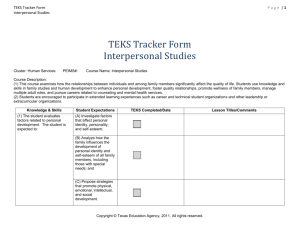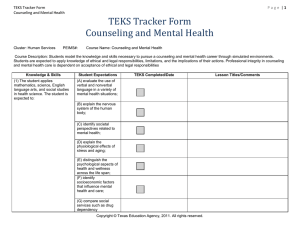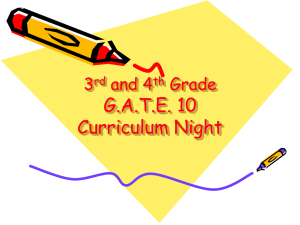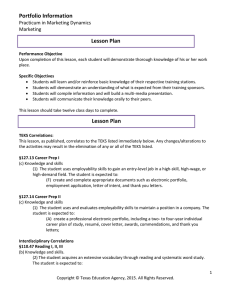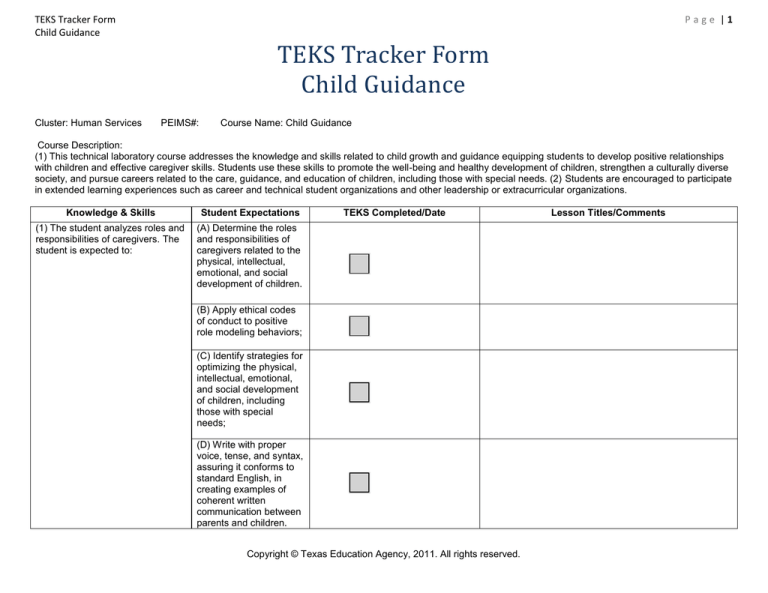
TEKS Tracker Form
Child Guidance
Page |1
TEKS Tracker Form
Child Guidance
Cluster: Human Services
PEIMS#:
Course Name: Child Guidance
Course Description:
(1) This technical laboratory course addresses the knowledge and skills related to child growth and guidance equipping students to develop positive relationships
with children and effective caregiver skills. Students use these skills to promote the well-being and healthy development of children, strengthen a culturally diverse
society, and pursue careers related to the care, guidance, and education of children, including those with special needs. (2) Students are encouraged to participate
in extended learning experiences such as career and technical student organizations and other leadership or extracurricular organizations.
Knowledge & Skills
Student Expectations
(1) The student analyzes roles and
responsibilities of caregivers. The
student is expected to:
(A) Determine the roles
and responsibilities of
caregivers related to the
physical, intellectual,
emotional, and social
development of children.
TEKS Completed/Date
(B) Apply ethical codes
of conduct to positive
role modeling behaviors;
(C) Identify strategies for
optimizing the physical,
intellectual, emotional,
and social development
of children, including
those with special
needs;
(D) Write with proper
voice, tense, and syntax,
assuring it conforms to
standard English, in
creating examples of
coherent written
communication between
parents and children.
Copyright © Texas Education Agency, 2011. All rights reserved.
Lesson Titles/Comments
TEKS Tracker Form
Child Guidance
Page |2
(E) Investigate the legal
responsibilities and laws
involved in caring for
children;
(F) Analyze the impact
of changing societal
patterns and
demographics on the
role of parents, children,
and other family
members;
(G) Access resources
available for effective
management of multiple
adult roles that affect child
care;
(H) Investigate parenting
skills and
responsibilities, including
child support and other
legal rights and
responsibilities that
come with parenthood;
(I) Analyze relationship
skills, including money
management,
communication skills,
and marriage
preparation; and
(J) Examine skills
related to the prevention
of family violence.
(2) The student analyzes child
care options. The student is
expected to:
(A) Compare child care
options for children at
various ages;
(B) Compare and
contrast the financial
considerations of child
care options;
Copyright © Texas Education Agency, 2011. All rights reserved.
TEKS Tracker Form
Child Guidance
Page |3
(C) Examine criteria for
selecting quality child
care; and
(D) Review minimum
standards for licensing
and regulations for
center-based and home
based programs.
(3) The student analyzes
responsibilities that promote health
and wellness of children. The
student is expected to:
(A) Identify signs of good
health and symptoms of
illness in children;
(B) Describe child
guidance practices that
contribute to the health
and wellness of children
such as requirements for
rest, exercise, obesity
prevention, public and
personal safety, and
sanitation;
(C) Apply safe
procedures in creating
environments for
children.
(D) Prepare nutritious
snacks or meals for
children following the
food guidelines in
promoting children’s
health such as portion
control, caloric
requirements, and
nutritional needs;
Copyright © Texas Education Agency, 2011. All rights reserved.
TEKS Tracker Form
Child Guidance
Page |4
(E) Determine resources
available for managing
the health care of
children such as
children’s insurance,
Children’s Health
Insurance Program, and
county health clinics;
(F) Recognize
symptoms of children in
family crisis situations;
and
(G) Discuss society’s
role in the protection of
children and families.
(4) The student analyzes the effect
of ply in the development of
children. The student is expected
to:
(A) Create examples of
play that promote the
physical, intellectual,
emotional, and social
development of children;
(B) Describe
characteristics and
safety features of
developmentally
appropriate play
activities, toys, and
equipment for children;
(C) Describe strategies
caregivers may use to
encourage constructive
and creative play;
Copyright © Texas Education Agency, 2011. All rights reserved.
TEKS Tracker Form
Child Guidance
Page |5
(D) Determine potential
uses and management
of technology, media,
and resources to foster
healthy child
development; and
(E) Determine
safeguards to prevent
misuse and abuse of
technology and media
with children.
(5) The student summarizes
appropriate guidance techniques
for children of various ages and
developmental levels. The student
is expected to:
(A) Identify the various
types of guidance and
the effects on children;
(B) Determine
appropriate guidance
techniques;
(C) Explain behaviors
that may lead to child
abuse; and
(D) Identify strategies
that deter abusive
behavior.
(6) The student makes informed
career decisions that reflect
personal, family, and career goals.
The student is expected to:
(A) Analyze the impact of
career decisions on care
giving.
(B) Propose short-term
and long-term career
goals;
(C) Assess personal
interests, aptitudes, and
abilities needed in the
child-care profession;
Copyright © Texas Education Agency, 2011. All rights reserved.
TEKS Tracker Form
Child Guidance
Page |6
(D) Exhibit employability
skills such as
communication, problem
solving, leadership,
teamwork, ethics, and
technical skills;
(E) Demonstrate effective
verbal, nonverbal, written,
and electronic
communication skills;
(F) Demonstrate skills and
characteristics of leaders
and effective team
members; and
(G) Evaluate employment
and entrepreneurial
opportunities and
educational requirements
for early childhood
development and services.
Copyright © Texas Education Agency, 2011. All rights reserved.


